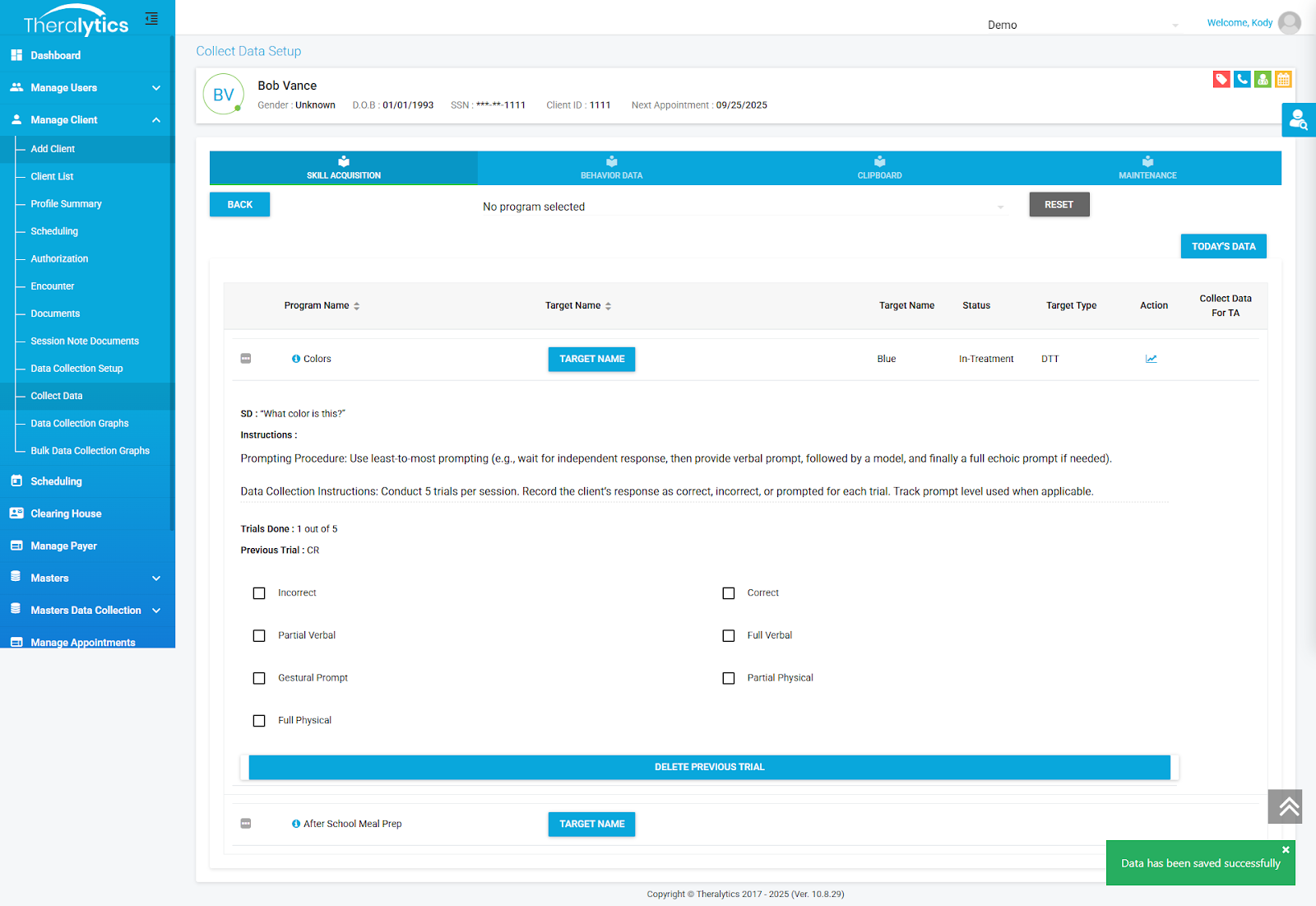Applied Behavior Analysis (ABA) therapy is an evidence-based approach that supports individuals with Autism Spectrum Disorder (ASD) and other developmental needs by building meaningful skills and promoting independence. The main idea of ABA is to use data to understand why people act the way they do and to help them make positive changes.
Collecting data in ABA therapy isn't just about filling out paperwork. It's how we track progress, create and adjust treatment plans, and ensure our clients get the support they need.
What is ABA Data Collection?
ABA data collection is how therapists track a person’s behavior and progress over time. It’s the process of observing, recording, and analyzing what happens before, during, and after a behavior, so decisions about treatment are based on real evidence, not guesswork.
By collecting data, therapists can see which strategies are working, what needs to be adjusted, and how the individual is improving. Whether it’s counting how often a behavior occurs, how long it lasts, or how quickly someone responds to a prompt, data collection helps make therapy more effective, personalized, and goal-driven.
6 Important ABA Data Collection Methods
1. Continuous Measurement
Continuous measurement tracks every instance of a behavior as it happens. This gives a complete view of how often, how long, or how intensely the behavior occurs.
Example: During a 30-minute session, a therapist records every time Liam asks for a break or engages in hand-flapping. By reviewing this data, they can see if requests are increasing while self-stimulatory behavior decreases, showing real progress in communication skills.
2. Discontinuous Measurement
Discontinuous methods sample behavior at set intervals instead of all the time. These include Partial Interval, Whole Interval, and Momentary Time Sampling. They’re ideal when continuous tracking would be too demanding or unnecessary.
Example: For a student who frequently calls out in class, the therapist uses 10-second intervals to mark whether the behavior occurred at any point during that window. This helps track general trends without watching every second.
3. Frequency Recording
This counts how many times a specific behavior happens within a defined time. It’s best for clear, countable actions.
Example: A therapist tracks how many times Ella greets her peers during recess. Over several weeks, the frequency increases from two greetings per break to six, showing improvement in social initiation.
4. Duration Recording
Duration recording measures how long a behavior lasts from start to finish. It’s great for activities where time engaged matters more than how often it happens.
Example: During homework sessions, the therapist measures how long Ben stays focused before getting distracted. As his attention span increases from three to eight minutes, the team can see measurable progress in sustained attention.
5. Latency Recording
Latency captures the time between an instruction and when the behavior starts. It’s helpful for analyzing prompt dependency or response readiness.
Example: When told “please start writing,” Ava takes 25 seconds before beginning. After several weeks of reinforcement and clear expectations, her latency drops to 8 seconds, showing faster task initiation.
6. Permanent Product Recording
This relies on the outcome or “product” of behavior rather than direct observation. It’s especially useful when the behavior leaves behind a visible result.
Example: Instead of observing every cleaning task, the therapist checks if the toys are correctly sorted into bins after playtime. The completed task acts as evidence of the target behavior (independent clean-up).
Types of ABA Data Collection
1. Skill Acquisition Data
- Tracks how a client learns new skills such as communication, social, or daily living tasks. Therapists use it to see progress and adjust teaching methods.
- Example: When learning to brush teeth, data shows how many steps the child completes independently and how much prompting they need.
- Measures: correct responses, level of prompting, percentage of independence.
2. Behavior Data
- Records challenging or target behaviors to track patterns and progress. Helps identify triggers and measure if interventions are working.
- Example: Counting how many times a student leaves their seat (frequency), how long it lasts (duration), or how quickly they respond to a prompt (latency).
- Measures: frequency, duration, intensity, latency.
3. Generalization & Maintenance Data
- Checks whether learned skills carry over to new settings or last over time.
- Example: After learning color names in therapy, the child is observed using the same skill at home or school weeks later.
- Purpose: ensures skills are practical and long-lasting.
4. Session Notes / Anecdotal Data
- Adds qualitative details like mood, engagement, or reactions that numbers can’t show.
- Example: “Client seemed tired but completed tasks with encouragement.” These notes help explain day-to-day changes.
- Purpose: gives context and supports data-driven decisions.
Why Data Collection is Important in ABA Therapy
- Tracking Progress – Data shows if a client is getting closer to their goals, learning new skills or reducing challenging behaviors over time.
- Personalized Treatment Plans – What works for one person may not work for another. By looking at an individual’s data, therapists can adjust teaching strategies, reinforcement, or goals to match each person's needs.
- Consistency in Treatment – In ABA therapy, accurate data ensures accountability and transparency across the entire clinical team, including caregivers.
- Meets Clinical & Ethical Standards– Data collection is part of evidence-based practice, ensuring therapy remains liable, transparent, and tailored to each client’s needs.
Tools for ABA Data Collection
Manual Data Collection
In the past, therapists used pen and paper, tally marks, and printed data sheets. These methods are simple, but they take a lot of time, are prone to mistakes, and can be hard to analyze quickly.
Digital Tools and Software
Today, many ABA providers use digital tools to make data collection easier. The benefits include:
- Entering data in real-time with a single tap.
- Creating and updating graphs and reports automatically.
- Sharing information easily with the care team.
- A lower chance of losing or miscounting data.

How Theralytics Helps With ABA Data Collection
Theralytics is built to make ABA data collection smoother, smarter, and more meaningful for therapists, teams, and clients. Here’s how:
- Real-Time Data Access & Capture
You can enter data during sessions, no need to wait until later. Theralytics supports multiple measurement methods (frequencies, durations, intervals, etc.), so your team can capture whatever data is relevant in the moment. - Customizable Curriculum & Goal Library
Theralytics provides a library of standard programs and goals that you can adapt for each client. This means your data collection is tied directly to the specific skills and behaviors you're teaching. - Advanced Reporting & Analytics
The platform turns raw numbers into visual charts, graphs, and filtered reports. You can view progress by staff member, behavior, or time period, and quickly spot trends. - Behavioral Insights & Decision Support
Beyond just collecting data, Theralytics helps you interpret it. It offers tools to analyze patterns, compare interventions, and make informed decisions about treatment adjustments. - Flexible Data Collection Methods
Whether you're doing naturalistic teaching (NET), discrete trials (DTT), or classic measurement methods like interval or duration, Theralytics adapts to your approach, so you don’t have to force your methods to match the tool. - Secure, HIPAA-Compliant System
Theralytics protects client information with high-level security features, ensuring that clinical and personal data stay confidential and compliant with relevant standards.
Best Practices for Data Collection
Collecting good data is an art. Here are a few tips to keep in mind:
- Keep it Consistent: Make sure everyone on the team is recording data the same way every time.
- Get Specific: Define the exact behaviors you're tracking. This ensures everyone knows what to look for.
- Review and Reflect: Check in on the data regularly. This helps you make timely, informed changes to the therapy plan.
- Aim for Accuracy: Double-check your entries. Small mistakes can sometimes lead to big misunderstandings.
Common Roadblocks in Data Collection
Even with the best intentions, challenges can pop up:
- Not Enough Time: It can be tough to juggle being present with a client while also taking detailed notes.
- Too Much Information: Sometimes, we collect so much data that it becomes hard to see the patterns that truly matter.
- Human Error: We're all human, and mistakes can happen, especially with manual data entry. This is where good training and the right tools can make a difference.
How Data Guides the ABA Therapy
Good data isn't just about numbers; it's about telling a story:
- Fine-Tuning Goals: Data shows us when it’s time to switch up a strategy, adjust a goal, or celebrate a newly mastered skill.
- Tracking Progress: Visuals like charts help everyone see a client's progress at a glance and confirm if the current plan is working.
Conclusion
At its heart, quality data collection is what makes ABA therapy work. It allows us to see what's happening, tailor our goals, and make sure our treatment plans are grounded in real evidence. When therapists, parents, and caregivers all work together to gather accurate data, they're creating the best possible path for success. Theralytics allows therapists to build detailed client profiles that outline treatment plans, target goals, and specific behaviors. Data can be collected directly within sessions, with graphs and reports generated instantly, saving time and creating more opportunities to focus on meaningful connections with each client.






.avif)
















